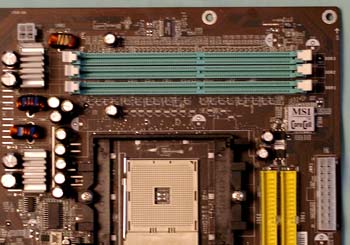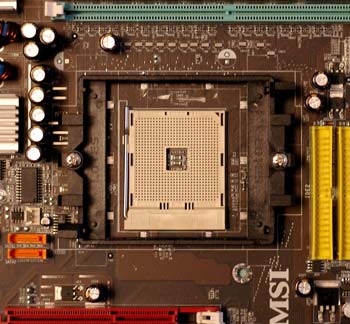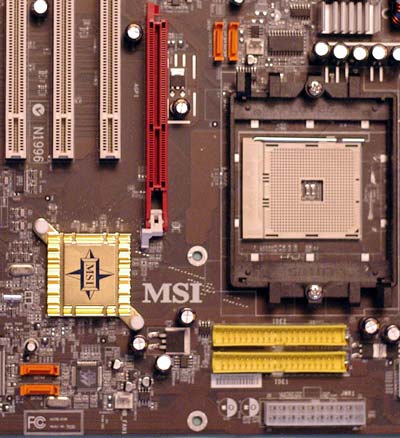MSI K8N Neo Platinum: First nForce3-250Gb
by Wesley Fink on April 26, 2004 12:05 AM EST- Posted in
- Motherboards
Board Layout: MSI K8N Neo Platinum
It is very clear that MSI had their own ideas about the layout of the K8N Neo.
The K8N Neo has a very different layout than the nVidia nF3-250 Reference Board. All-in-all, we find the MSI layout to be excellent. Memory at the top of the board works fine in most case designs, and it does keep the DIMM sockets clear of interference from the AGP slot.

The ATX 20-pin and the 4-pin 12V connector are separated in the K8N Neo, but the locations work well nonetheless. The bulky ATX connector is on the far right edge on the upper half of the board. The 4-Pin connector is on the opposite side of the CPU, at the very top edge of the K8N Neo. Both locations are clear of other connectors and should not interfere with air flow.

The CPU socket is in the center of the board just above midline. PCI slots are below the socket and memory is above it. There is plenty of room around the Socket 754, so just about any Heatsink/Fan should work fine. We had no problems mounting a Zalman 7000 on the K8N Neo.

The IDE connectors are in our preferred upper right edge of the motherboard, where they rarely interfere with other connectors. SATA connectors mirror the nF3-250 Reference Board in that 2 are between the AGP slot and the CPU and 2 are near the lower right edge of the board. The arrangement looks worse than it functions, since the SATA cables are very small. However, SATA connectors are still far too fragile for our liking and anything that gets them away from "high-traffic"" areas of the board is preferred. You need to be extremely careful while changing a video card or replacing a HSF, to avoid pushing and breaking off the SATA connectors between the AGP and CPU. The other 2 SATA connectors are better located near the right edge so that they are out of harm's way.
We would not be complaining about this if SATA connectors were more durable. We have never broken a big, bulky IDE connector, but with board testing, we have broken SATA connectors off 2 drives and 2 boards. Whoever came up with this fragile design for connecting hard drives should be forced to review motherboards or test memory and CPUs. They would then learn quickly that the SATA connector needs to be stengthened.

Unfortunately, the floppy connector is located on the lower right of the board. This will work fine in some case designs, but it will be a difficult reach in tower cases. It is also a location that makes neat cabling difficult in most cases.

The K8N Neo has 5 PCI slots. The bottom PCI is configured as a dedicated communications slot and is identified by a different color. The AGP slot uses the common "push to release" lever that works fine with most cards, but can be a real pain with very large top end cards like the nVidia 5950U. MSI placed all the headers along the lower edge of the board, which really helps when you are trying to do a neat cable arrangement in a window case. The downside is that if you use audio cables with optical drives in a tower case, they probably won't reach the 4-pin connectors in the lower left corner of the board. Like the disappearing floppy, audio cables are rarely required any more, but if you need them, this location can be a challenge in some case designs.
While there are improvements that could be made to the K8N Neo layout, it is clear that a lot of thought went into the MSI layout. Overall, the board was a joy to set up, with the exception of the SATA 1/2 and Audio connectors.










26 Comments
View All Comments
kmmatney - Tuesday, April 27, 2004 - link
Ahhhhhh! A long spiel about how great the board is at overclocking....and then no overlocked benchmarks!! I want to see how much gain you get! How about a single game and encoding benchmark?Pumpkinierre - Monday, April 26, 2004 - link
I agree with #10, Wesley, you should include at least one synthetic with your overclocking tests because you have'nt done any good overclocking/high FSB tests on a64s as you havent had a mobo with good PCI/AGP lock or >250 FSB til now. It makes me wonder why because you are thorough with the p4/i875 and by your own admission the gigabyte and shuttle nF3-150 have PCI/AGP locks and ClockGen adjusts the FSB. The location of the a64 memory controller ondie means the memory sync/async tests results from intel systems cant be translated to the a64 ones. So, in my opinion, for conservative a64 overclockers, benchmark results at the same cpu speed but different FSB (clockspeed) sync or async and HT alteration would be of good use. I know you are just seeing the limits etc. but you must be running stability tests so it costs you nothing in time to throw in the sandra or Memtest86 bandwidths or even 3DMark2001/2003 results.And I agree there is merit in running cool and quiet with overclocked systems(if possible) as the windows software overclockers are still not perfect and only available on some brands.
Jeff7181 - Monday, April 26, 2004 - link
Wesley,It may not really fit in with a motherboard review, but seeing as how it seems overclocks on the nF3 150 and KT800 chipsets have been limited by the motherboard, it makes sense to test the overclocked performance to see if it's worth paying for a motherboard with lower performance at stock speeds that might provide a lot better performance once overclocked. For example, if the nF3 250 can only match KT800 performance after overclocking, it makes the choice much more clear.
cnq - Monday, April 26, 2004 - link
Wesley,Thanks for the quick response. Glad to hear you are considering mixing manual overclocking with cool'n'quiet in future tests.
You mention that "I am not convinced that it matters to most overclockers". I think that's just because c'n'q' is fairly new. If you tell them that c'n'q is just the thing to help prolong the life of their overworked system, they'll start paying attention. Only those who run 100% cpu utilization 24/7/365 won't care.
For the rest of us, mixing Cool'n'Quiet with overclocking makes perfect sense (throttle back the cpu when just web browsing; crank it up to overclocked when you need a burst of bower, which in my case is compiling. Note that I'm not counting MSI's CoreCell auto-overclocking because it's not powerful enough...)
I'd also claim that Cool'n'Quiet is *doubly* useful in a heavily overclocked system. Such systems are often on the ragged edge of overheating, and thus could benefit more than anyone from throttling at times of light or moderate load.
Naturally, when the load jumps back up, we'd want the fully overclocked manual settings to automatically kick back in. And that's the rub. Will that part work?
Has anyone tried running Cool'n'Quiet on a manually overclocked A64? Does it (a) work perfectly, (b) crash, (c) not crash but "forgets" your overclock settings, (d) other? I'm guessing it will crash, esp. if manual overclock settings included changing the CPU voltage or raising the HTT while lowering the CPU multiplier. Hoping to hear I'm wrong (for at least one A64 board) before making purchase...
Schnieds - Monday, April 26, 2004 - link
Do you have any idea when this motherboard will be available for purchase in retail outlets? From the review it sounds like this board is a release version and ready for retail, but no one seems to know when it will actually be available for purchase... Thanks for the great review.Wesley Fink - Monday, April 26, 2004 - link
#7 - nForce3 chipsets automatically control Bank Interleave and Command Rate - there are no manual options. Some VIA chipsets do allow interleave and command rate settings. We always specify the setting we used in the review - if those settings are available. If they are not an available option we state NA for Not Available in our Memory Stress Testing tables. We also always enable interleave if it is an option.#8 - I added Cool'n'Quiet to the Feature list at your suggestion. Most overclockers turn off auto features for overclocking, because frankly I can always out-tweak Auto settings on OC. I will consider doing more with Cool'n'Quiet in overclocking, but I am not convinced it matters much to most overclockers.
#9 - Corrected. Not to be defensive, but if you want to see how much AnandTech found with this board that other sites missed, read through K8N Neo reviews that others have posted.
#10 - What would it take to make you happy on OC results in board reviews? I have explored 1:1 vs aynch in memory reviews. Performance results at a full-range of OC and timings are always a part of memory reviews. What would you like to see in motherboard reviews?
Jeff7181 - Monday, April 26, 2004 - link
No overclocked comparisons? Awwww man... questions still unanswered...KillaKilla - Monday, April 26, 2004 - link
How well did the Albatron GeForce FX5950U work with those ATI Catalyst 4.4 drivers?Not to be sarcastic, but simply alerting those who can correct this to the typo.
cnq - Monday, April 26, 2004 - link
Wesley,You mentioned that you disabled Cool'n'Quiet to prevent possible interference with overclocking.
I wonder if it's even worse than "interference": is it even *possible* to run Cool'n'Quiet on a heavily overclocked system? (especially one with aggressive overclocking: significantly raised HTT with lowered CPU multiplier).
This is one of those things that should be a FAQ, yet no one seems to have tried. Cool'n'Quiet is the perfect complement to an aggressively overclocked system: prolonging its lifespan by giving it a "breather" when just (e.g.) web browsing. But are Cool'n'Quiet and overclocking compatible?
(Pls refer to my same question in your Aopen AK89 Max review for specific technical reasons why I think c'n'q and aggressive overclocking may not be compatible. I hope I'm wrong.)
Myrandex - Monday, April 26, 2004 - link
My K8T Neo supports cool and quiet completely, and toms hardware confirms this too with an older A64 mobo roundup. Looks like a hell of a board, but I am wondering why so many reviews at Atech are run w/ Bank interleave set to disabled. I remember back in the K6/2 days, this was a major bios tweak for memory. Does it not matter, or negatively effect performance now?Jason